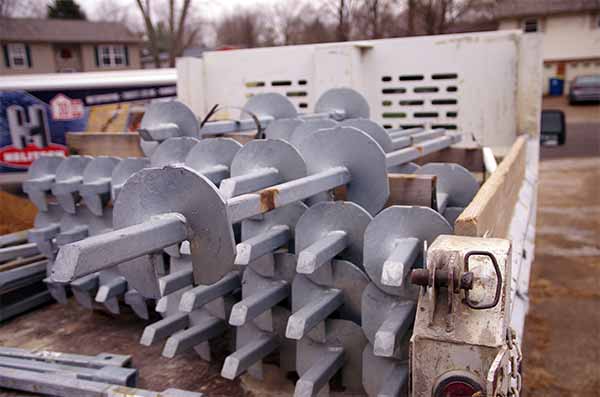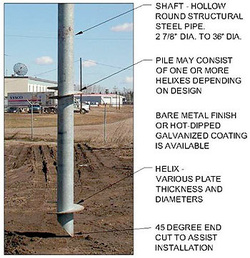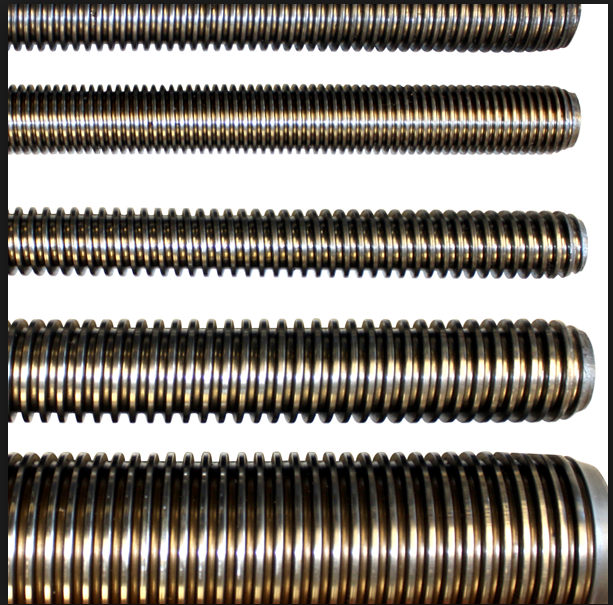| Author | Message | ||
Tootal |
I'm not sure Vern. I don't think so because everybody pays into the fund through their insurance company. You contact your insurance man and then they contact the Illinois Mine Subsidence folks. I'm not too worried about it since the piers will be roughly 25 feet deep and in more solid material. It's common for a walk out basement to settle in this fashion because the footing near the walk out is on less compacted dirt compared to the rest of the house. Mine was just helped along by the subsidence. It will be much stronger once piered. They are screwing the piers in this morning. I'm heading out soon to video it and take some more pics. | ||
Tootal |
 These are the helical piers. Here is a video of them being installed. Sorry for the sideways video but if I flip it it's too small: https://www.youtube.com/watch?v=U58b8wHJeqU | ||
Court |
Hahahaha . . . I have put in thousands of those A. B. Chance (Centralia, MO) helical anchors (now used as piers) over the years . . . . I've also got a couple hilarious stories while installing them. They work very well. | ||
Tootal |
I've also got a couple hilarious stories while installing them. Remind me to listen to them sometime! | ||
Etennuly |
Well you should end up well anchored in case of a tornado strike!! | ||
Tootal |
 Never thought of that but after what Court said, it makes sense! He's absolutely right about the company who makes them. The picture shows a double helix but they weren't good enough so they ended up with triples. They have about 5 more to install today and then they start attaching the brackets to the footing then the pier to the bracket. | ||
Etennuly |
Now you will need to build an exo -skeleton over the house like a roll cage attached to those anchors, then cover the whole exterior with 1/2 inch steel plate. Then you can have us over for tornado parties!  | ||
Tootal |
The weather here is a little strange. The heat of the city of St. Louis tends to split storms in half. You can watch it on radar. We all call it the arch effect but that's just a joke. The direction from where the storms usually come get split and go to the North and South of us. I'd say over 50% of the time this happens. I have seen straight line wind sheer a mile away from me. It's amazing what that does to a corn field! | ||
Buellish |
"Then you can have us over for tornado parties!" I'll be heading over to escape the zombie apocalypse!And maybe for a beer,I hear Greg might have one or two! | ||
Etennuly |
We have that same weather phenomenon here east of Knoxville. The heat of the city moves it around us. A degree or two can move a big mass of weather. We also have the effects of the natural geography. Plateau to the west then the valley where Knoxville lies, then the mountain range. My place is kind of sheltered by it all. Frequently we watch the bad storms pass by to the North following a mountain ridge. | ||
Tootal |
I have one or two of several things you might need during the zombie apocalypse! You're welcome to join me! Well I just got word that they are pulling the piers back out. The dirt around them is too soft so now they have to go to round piers and grout them. I have no idea what that means. The jackhammers are in the basement tearing out the perimeter concrete. It's enough to give a woodpecker a headache! | ||
Ourdee |
Film at 11? | ||
Etennuly |
So they never reached torque spec then. Interesting but sad. Would have thought they could decipher that by doing core samples. | ||
Greg_e |
Surprised they aren't injecting grout into the ground to strengthen it. (Message edited by greg_e on December 08, 2017) | ||
Tootal |
I went out, after it got above freezing, and talked to the leadman. He explained that the dirt on top is too loose to keep the square piers from flexing. So they back them out and replace the top ten feet of square extension with 2-2/8" hollow pipe. Once they reach torque again they fill the pipe with grout to keep it stiff. | ||
Crusty |
Well; That should oughta put lead in its pencil. | ||
Etennuly |
Is the whole area like that, or did your house draw the short straw? I've had a little experience following this along from living near sink holes in Florida and from watching and reading about the National Corvette Museum when it sunk. | ||
Tootal |
Well; That should oughta put lead in its pencil. I told the guy the same thing!! Great minds think alike! There are many mines in this area. The whole neighborhood has moved, I just happened to be at the tip of the arrow pointing at the "event". These guys are very experienced in this area. Many mines legally had to leave so much coal behind in order to support the ceiling. However, many of them, on their way out, took the coal from the supports thinking the engineers were keeping them safe but since they were leaving, who cares if it caves in! Nice guys! | ||
Blake |
Those "piers" look like tension bearing anchors, not like any screw-in pier I've seen. Unless they are using the pull-down technique. See The piers will be supporting the full weight of the house. Column buckling capacity is proportional to diameter to the 4th power and inversely to length squared. Lateral support by soils is not something that can be relied upon. Get yourself a good structural engineer to review the installation. If they aren't using the grouted pull-down method, It looks suspect to me. Proper conventional screw-in pier...  The minimum 2-7/8" would apply to a wooden deck or other lightweight duties. (Message edited by blake on December 09, 2017) | ||
Tootal |
I can't speak to the technology just that the company is called Helitech and is rated A+ at the BBB and have been in business for many years. They have their own engineering dept. and have done many houses in this area. I'm just relying on them to do the right thing. They have a transferable lifetime warranty and so does the pier company. I do know that once you get so deep we have a lot of clay in the soil here. | ||
Blake |
Any idea how they get the screw-piers underneath the footer? I had some foundation repair done on the rent house a few years ago, ten piers in total. They essentially used the house (post tensioned slab) to pile drive pier segments to refusal. I keep thinking that there's gotta be a better easier/cheaper way. Looks like the screw pair folks may have found a way. | ||
Tootal |
These just screw in the ground until they reach a certain torque to turn them. They then know at that torque they will hold a certain weight. There are 28 of them about 6 feet apart. They attach the piers onto an L bracket bolted to the footing. They then put in hydraulic jacks to lift the house. Once it's lifted they have two pieces of all thread with nuts to lock it in position. | ||
Court |
>>>all thread Weaver Rod  | ||
Tootal |
Looks like some V, acme and square threaded rods. Since the weight is all in one direction I'm surprised they don't use a buttress thread! | ||
Etennuly |
I don't know why they don't a fix a bridge beam under the floor like an outrigger beam, extending about ten feet beyond each side. Something like the building movers use. Extending the house's foot print. Seems a more permanent and easier to adjust idea. Does not seem like that would be anymore expensive. | ||
Ratbuell |
A horizontal outrigger beam / under-slab "joist" beam would require a LOT more excavation in order to slide it into place...this sounds - to my non-engineer self - like a pretty slick setup. I presume that once they jack up the house and anchor it to the brackets, they inject grout into the space under the slab for full support? | ||
Tootal |
That beam would be sitting on the same soft soil that's been moving. The piers go into the hard clay that's much more compact. The weight of the house is then transferred to the piers and is less likely to move again. The piers are in strata almost 25 feet down. They lift the footing with the piers and they hold the footing. There will be just dirt under the footing as we don't need there support anymore. | ||
Etennuly |
Oh. So there is actual firm strata to grip and support them. I was assuming that sitting over soil that is collapsing into a mine, ala the Corvette Museum, that a wider foot print might make the house more buoyant spreading the load over a larger area. But I am just a bodyman who in a small way, deals with physics every day, I certainly appreciate,but don't pretend to know how to use those words Blake carries in his vocabulary.  | ||
Court |
I am currently doing the geotechnical work for 14 miles of new power line that we'll be flying in with Sikorsky Sky Cranes in the coming months. We have a huge variety of geology and one time to get it right . . . 184' towers with lots of loading. We'll be using some really innovative systems and will fly personnel, cranes and concrete in. I used to be very active in the ADSC (Associated Drilled Shaft Contractors) and write for their magazine from time to time (legal issues, not technical) and have drilled and placed thousands of foundations. I am always fascinated with the work our geologists do. . . . pretty amazing. A. B., Chance first introduced the helical screw-in piles as distribution pole anchors for guy wires. Later they made larger versions, which we installed with a modified Texoma 330 drill rig, as transmission anchors. It wasn't unusual to put 50' to 100' of extensions in. One of the concerns was directional control . . . it was mostly a matter of luck. I was installing one once, out in a field near LaCynge, KS, and kept slapping in extension after extension. . . . after about 30 minutes my partner taps me on the shoulder and points out into a nearby field where are 30' of the square shaft and several flights of anchors were flopping like fish on the shore as I turned the shaft at the machine. Later the helical piles were found to be capable of supporting compressive loads by installing them into proper bearing strata and affixing anchoring systems to the rod. One of my funniest, and damn sure memorable, experiences was the anchorage for the Bowersock Dam behind the Lawrence, KS city hall. I've long maintained, in the world of construction, that a person should stick to what they know and do well. Bowersock, as a young kid, shaped that thinking. I saw the bid pop up on Dodge Reports and knew no one would bid it. I told my Dad . . ."we can make a killing". He, wisely, asked me "why do you think no one is bidding it?" Undeterred I put together a bid package, priced at what I thought was a King's ransom . . . . I was the only bidder. Dad's words . . . "you bid it, you build it". I sure enough learned some lessons. No access . . . I had to disassemble the large trailer mounted anchor machine and rent a LARGE enough crane to lift the frame over city hall . . . then the in-line 300 c.i. Ford Industrial motor . . and all the hydraulics . . . I reassembled the entire machine down in the 18' deep hole that the anchors would be placed in. I had to keep the crane to lift and reposition the machine for each anchor. I was a solo . . . one man construction crew . . . for several weeks. I've long maintained, to my students and audiences when I speak, that there are 2 ways to burn through LOTS of cash quickly . . . they are construction and cocaine. I lost my ass on the job . . . . .my dreams of buying my private plane with the "Bowersock Bounty" dripped away, drop by drop in the form of sweat, during the weeks I worked in that hole. And . . yep, you guessed it. I have, here in the office, all the pictures from that project. That one was likely on the $100,000 order of magnitude . . . but it's served me well on projects like the current $2 billion project . . . the upcoming Northern Pass and Sun-Zia. But . . . I continue to do stupid shit now . . .even in my sunset years . . . and depend on folks like Blake to save my ass. It's a great business. | ||
Tootal |
Vern, the mine subsidence happened somewhere back in the woods behind the neighborhood. It draws the upper layer of softer soil toward it. On a house with a walk out basement the footing on the corner of the walkout is sitting on softer soil than the other end of the house since it is dug into a hill. Contractors should put the footings near the walkout deeper into the ground to keep this from happening. I've been told this is a common problem with homes of this design. The mine "event" just helped my house along. Court, thanks for all the info and stories. I know you have many! |